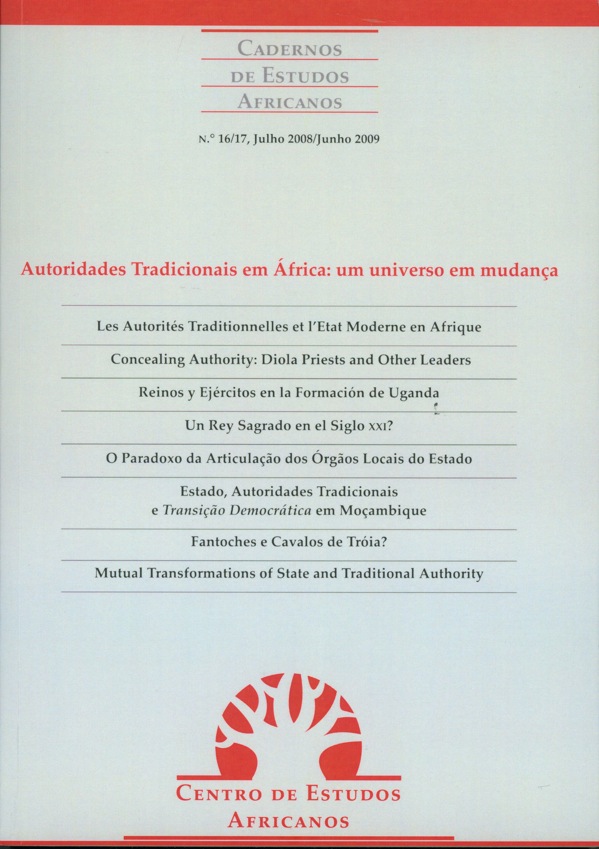Concealing Authority: Diola priests and other leaders in the French search for a suitable chefferie in colonial Senegal
DOI:
https://doi.org/10.4000/cea.181Palavras-chave:
Autoridade tradicional, Administração colonial, Diola, Casamata, SenegalResumo
This article aims to explain the complexity of the relationship between Diola (or Joola) chiefs and the French colonial administration. After presenting the general Diola context, the author focalizes in Diola-Esulaalu and Diola-Huluf populations, both south of the Casamance River. In this area, the traditional authorities were the leaders of the anticolonial resistance. For this reason, French officials turned to early Diola converts to Christianity to try to control the population. According both to oral information and to colonial archives, the French administration never controlled the leaders of Diola traditional religion (awaseena) or, consequently, the Diola population.Referências
Afigbo, A. E (1972). The warrant chiefs: Indirect rule in Southeastern Nigeria 1891-1929. New York, Humanities Press.
Ajayi, J. F. A.; Crowder, Michael (1975). “West Africa, 1919-1939: The colonial situation”, in J. F. A. Ajayi and Michael Crowder (eds.), History of West Africa, II. New York, Columbia University Press, 514-541.
Akpo-Vaché, Catherine (1996). L’AOF et la Seconde Guerre Mondiale (septembre, 1939- octobre, 1945). Paris, Karthala.
Arens, W. (1979). The man-eating myth: Anthropology and anthrophagy. New York, Oxford University Press.
Baum, Robert M. (2004). “Crimes of the dream world: French trials of Diola witches”, International Journal of African Historical Studies, 37 (2), 201-228.
Baum, Robert M. (1999). Shrines of the slave trade: Diola religion and society in precolonial Senegambia. New York, Oxford University Press.
Baum, Robert M. (2001 [1989]). “Alinesitoué: A Diola woman prophet in West Africa”, in Nancy A. Balk and Rita M. Gross (eds.), Unspoken worlds: Women’s religious lives. Belmont, CA, Wadworth Press, Third Edition, 179-195.
Monod, Th. et al. (org.) (1951). Description de la côte occidentale d’Afrique (Sénégal au Cap de Monte, archipels) par Valentim Fernandes (1506-1510). Bissau, Centro de Estudos da Guiné Portuguesa.
Girard, Jean (1969). Genèse du pouvoir charismatique en Basse Casamance (Sénégal). Dakar, IFAN.
Linares, Olga (1992). Power, prayer and production: The Jola of Casamance, Senegal. Cambridge, Cambridge University Press.
Maclaud, Dr. (1907). “La Basse Casamance et ses habitants”, Bulletin de la Société de la Science de Géographie Commerciale de Paris.
Mark, Peter A. (1978). “Urban migration, cash-cropping, and calamity: The spread of Islam among the Diola of Boulouf (Senegal), 1900-1940”, The African Studies Review, 21, 1-12.
Pélissier, Paul (1966). Les paysans du Sénégal: Les civilisations agraires du Cayor à la Casamance. St. Yreix, Imprimerie Fabrègue.
Roche, Christian (1976). Conquête et résistances des peuples de Casamance (1850-1920). Dakar, Nouvelles Editions Africaines.
Downloads
Publicado
Edição
Secção
Licença
Direitos de Autor (c) 2016 Cadernos de Estudos Africanos

Este trabalho encontra-se publicado com a Licença Internacional Creative Commons Atribuição-NãoComercial-CompartilhaIgual 4.0.
Autorizo a publicação do artigo/recensão submetido do qual sou autor.
Declaro ainda que o presente artigo é original, que não foi objecto de qualquer tipo de publicação, e cedo em exclusivo os direitos de publicação à revista Cadernos de Estudos Africanos. A reprodução do artigo, no todo ou em parte, noutras publicações ou noutros suportes depende de autorização prévia da editora Centro de Estudos Internacionais do Iscte - Instituto Universitário de Lisboa.

